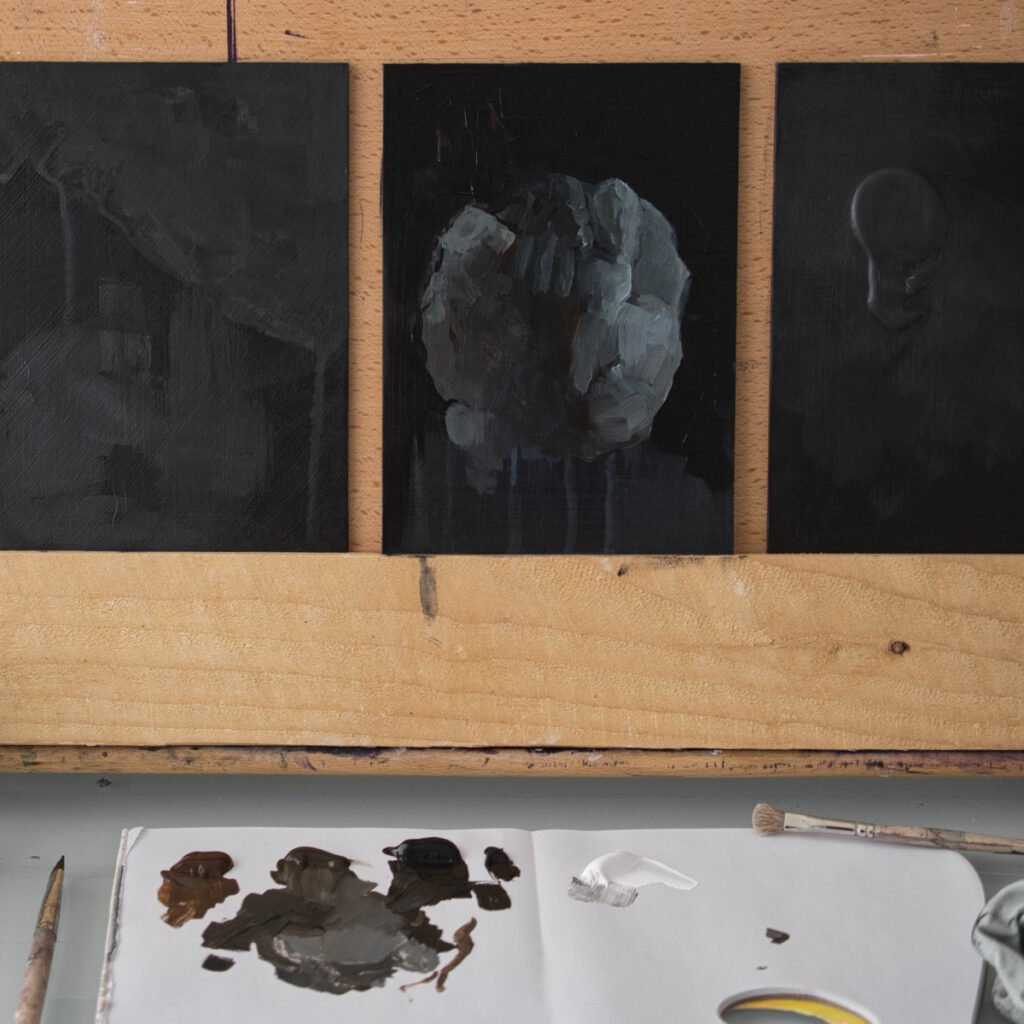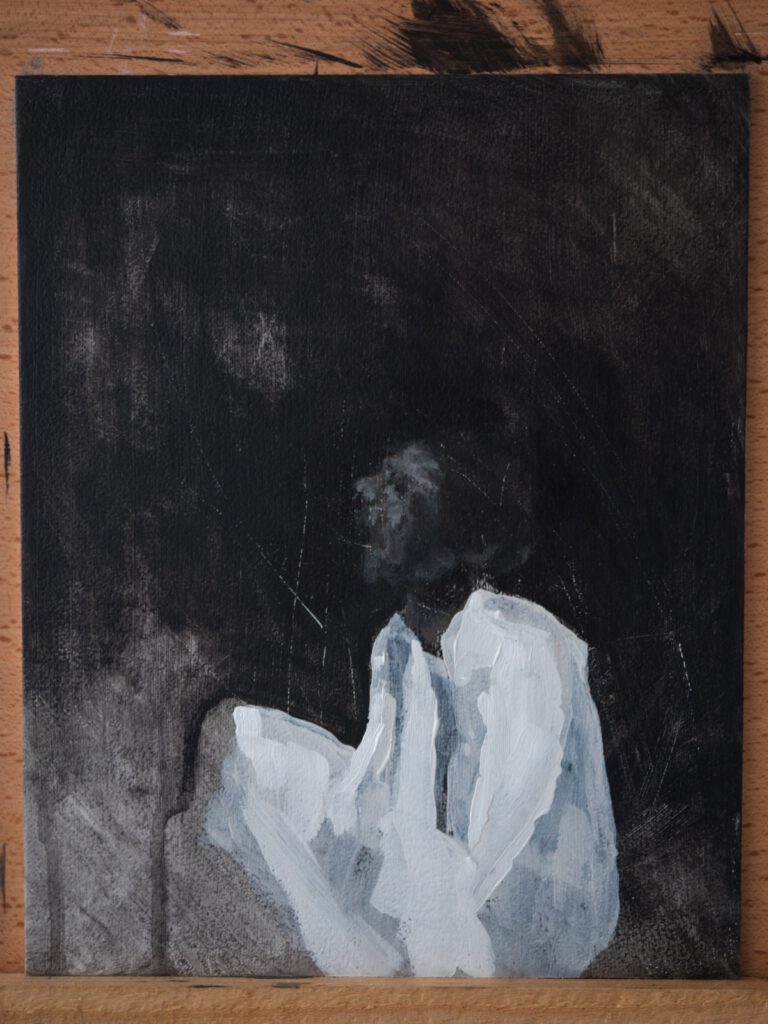It was a nice ride last week; ideas were abundant and all worked out in sketches. Pencil and charcoal give me peace of mind, as colour is something I don’t have to wrestle with. Then a moment of panic washed over me; how in anyone’s name am I gonna translate this into a painting? What substrate? What medium? What am I gonna DO?!
Don’t worry, that’s all the drama for now in this journal. 🙂 I figured that, before my encounter with Janneke, I already had a plan to dedicate some time to learning. Exploring. Experimenting. All that, while staying sober, mind you. I preach to my students about the importance of it all, but at the same time they know I struggle with it as well.
But I had agreed on it, and that in itself calms me down. My sketches won’t go anywhere and with a little luck, all this self-discipline will result in more clarity on what I want to put on my damn canvas.
That brings me to the main topic of today’s journal: I ditched my canvasses. Yes. I promised you less drama, here it is. Let’s talk about substrates. Or at least, let me tell you about mine and then you can go ahead and put all your troubles/experiences/questions etc in the comments. 🙂

I worked on heavy paper for a long time, until I felt that I needed something that might last a little longer. Canvas is the obvious choice, since we’ve been using that since we stopped painting exclusively on our cave walls. The thing with stretched canvas, is that it’s bouncy. Some people like this bounce, but I’ve come to learn that I hate it more than Walter White hates that housefly.
I need something sturdier. I worked on unstretched canvas for a while, because it allows clients to have the work stretched by a professional. It’s also easier to ship, especially internationally. Unstretched canvas can be temporarily mounted to a panel or your wall even. You can buy it in bulk, rolled up, so it’s very easy to cut to any size or dimension you want. Hell, you can even cut it into whatever shape you want and go for it.
But however fine a weave you buy, it will of course have a canvas texture. And that didn’t work for me, in general. I like to control my texture from the start so my first preference is a smooth surface.
Next in line are panels made from wood. I like panels. I’ve prepared a few myself in the past and when you make sure they’re sealed properly on all sides, they can last a long time. I feel this is the advantage that panels have over canvas, which is usually unsealed at the back. You can prime and sand and repeat that until you have a finish as smooth as you want it. It can also take some force, both in application of paint as well as the weight of impasto.
Wooden panels however, are expensive. At large sizes, they also become unreasonably heavy which is an issue when you want to hang them.
For a while now I’ve wanted to try something that I came across a year or two ago; aluminium di-bond panels. I purchased a few of them, cut to size, for some canvas to mount. But now I wanted to see if I could prime them like wood panels.
A short description: di-bond panels (or sandwich panels) are made of a core of polyethylene pressed between two thin layers of aluminium. It’s used for industrial, road and commercial signs that are often on display outside. That makes it ridiculously weather-resistant and relatively light in weight.
The question of course was; will it hold paint and not magically eat my primer? I assumed it would work because why not, but I’m no hero in this department so before ordering, I consulted Youtube and found out Aaron Nagel already did the work for me, bless him. If you check out his video, make sure to give it a like so it’ll show up more often for other artists.
My plan affirmed by a man who looks like he knows what he’s talking about, I went ahead and ordered a bunch of smaller sizes for my months of experimentation. I ordered the 4 mm thick panels and had them cut to a few sizes. I’m in no mood to cut freaking aluminium myself and the supplier I order with did it at almost no charge. Previously, I had ordered 3 mm thick panels, which are also great but I feel that anything over 15 inch benefits from the rigidness of 4 mm panels.
I sand them well, especially the edges because they can be nasty sharp. Then I clean them, and a final time with rubbing alcohol. And then you can prime, just like you do any other substrate.
So far, I enjoy them very much. They’re light and cost effective. I’m even thinking about mounting them into a frame with magnets at some point.
So I currently have a bunch of 5×7 inch panels ready, half primed black, the other half white. Over the next few weeks I’ll be doing texture stuff, contrast stuff and medium stuff. Lots of stuff, you can tell. These two are the first from my sketchbook, and are modelled by the wonderful @dinoopis.
I started with a limited palette of Raw Umber, black and white. I’m working with Golden Open. The weird textured blob is a dried out pool of acrylic medium but its shape is freaking me out, so I might try to hack it off.

I started the panel above based on the sketch I posted last week. This one is an 8×10 inch panel, which is still relatively small for what I usually work on. But when you work for a while on 5×7, this size seems like so much room to breath. It’s funny how that works. I also started this on white primer. The advantage in that, is that you can create better texture in your black paint, the way you can in charcoal. The scratches are done with a needle and some steel wool.
So that’s it for this week! If you have any questions about any of this, let me know down in the comments. And I hope to have some work done before my next update. Have a great week! <3

6 responses to “Direction”
Wow, Sabra! You are so creative and go HARD at experimenting with your ideas! Very impressive and inspiring. Thank you for sharing!!
Struck and inspired by your instinctive need to explore. Thx for sharing your process, not only is your writing style a pure delight – you’ve got my creative flow going too!
Thanks for the info on the aluminum panels!! I don’t think magnets stick to aluminum tho. Let us know! I look forward to seeing what you create!!
Oh thanks for pointing that out! I just searched for it and of course you’re right, it’s a paramagnetic material. I might have remembered that had I payed a little more attention in high school haha 😛
Thank you so much for sharing all this. I made the move myself from unstretched canvas to wood panels eventually and I’m so interested to hear about your continuing adventures with substrates. You always tackle the subjects that roll around in my head and keep me awake at night – just brilliantly! You write with such authenticity and clarity about creative struggles and I always come away having learned and being given nourishing food for thought! Thank you Sabra.
Thank you for sharing your hard work and soul with us! You are not only an incredible artist/writer you also have a heart of gold!